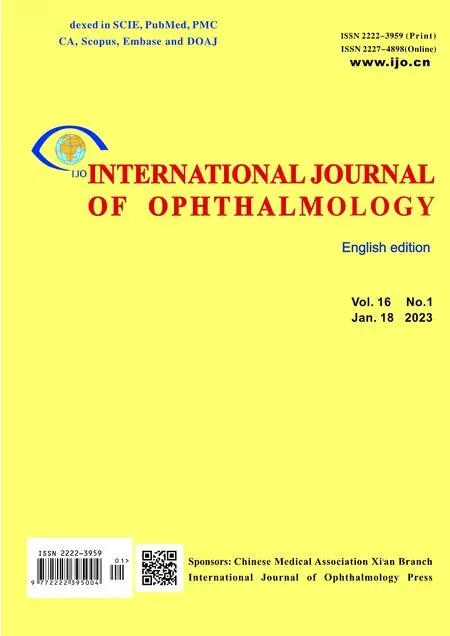Comparison of complication rates between femtosecond laser-assisted cataract surgery and conventional phacoemulsification cataract surgery
Eric Y Jin, David Z Chen,2
1Yong Loo Lin School of Medicine, National University of Singapore, Singapore 117597, Singapore
2Department of Ophthalmology, National University Hospital,Singapore 119074, Singapore
Dear Editor,
We read with interest the Meta‐analysis conducted by Chenet al[1]on the clinical outcomes and complication rates between femtosecond laser‐assisted cataract surgery(FLACS) and conventional phacoemulsification cataract surgery (CPCS). The authors reported no statistical difference between both methods for all measured complications except posterior capsular tear, with CPCS displaying a higher rate of posterior capsular tear. Since its inception in 2011[2], FLACS has been extensively compared to CPCS as a viable option to remedy cataract in patients. FLACS involves using a femtosecond laser to assist in the initial steps of the cataract surgery, such as clear corneal incision, capsulotomy, and lens nucleus fragmentation. However, much debate remains on this topic, with studies even claiming that there is no difference in visual outcomes between both methods[3].
The Meta‐analysis conducted by Chenet al[1]on 25 randomized controlled trials (RCTs) collected before November 2, 2019 compared parameters such as visual outcomes and complication rates between FLACS and CPCS.However, this excluded two important new RCTs, namely the FEMCAT[4](n=1389) and FACT[5](n=780). Since intraoperative and postoperative complications are uncommon,the additional of these two large multicenter trials, among other newer studies, could improve pooled estimate of their incidences. As such, we complemented the previous Meta‐analysis with data from studies after November 2, 2019 to obtain more comprehensive and updated results.
We used the original search protocol and expanded the dates to June 12, 2022 (inclusive). Only RCTs published in the English language with relevant comparisons in clinical outcomes and complication between FLACS and CPCS were included, and searches were made in PubMed, EMBASE, and the Cochrane library. Statistical analysis was performed using RevMan 5.4.1 using the methods as described by the authors.
A total of 8 additional RCTs[4‐11]were selected. Characteristics of all the studies, including those used in Chen’s study when comparing complication rates, are described in Table 1[4‐19].Forrest plots of intraoperative and postoperative complications is detailed in Figure 1.
Overall, CPCS resulted in higher rates of posterior capsular tears than FLACS. However, subgroup analysis using only the newer studies showed no statistical difference between the two groups. Likewise, there was a trend towards higher incidence of capsular complications excluding posterior capsular tears in CPCS, though this was not statistically significant. There was also no significant difference between the 2 groups in occurrence of macular edema and elevated IOP.
While our study reinforces the findings by Chenet al[1]that posterior capsular tears are more common in CPCS compared to FLACS, the majority of difference was the result of one study by Stanojcicet al[10]. We note that study had an unusually high rate of posterior capsular tear for the CPCS group at 3%, which was atypical since the mean predicted posterior capsular tear risk was 1.59%. Nonetheless, the inclusion of 2436 cases from 4 new studies are a significant increase from the 474 cases from the 2 studies in the original Meta‐analysis,and a pooled statistically significant difference in posterior capsular tear rates provides more corroborating evidence that suggests FLACS has greater intraoperative safety. Posterior capsular tear is a serious intraoperative complication and can often result in significant increase in follow‐up medications and procedures for patients[10]. In addition, the trend towards higher incidence of capsular complications other than posterior capsular tear further suggests at the intraoperative safety profile of FLACS over CPCS. More research is needed to explore the cause for increased rate of posterior capsular tear during CPCS, and standardized prospective studies designed to specifically evaluate surgical complications between FLACS and CPCS may be helpful.

Figure 1 Intraoperative and postoperative complications A: Incidence of posterior capsular tear; B: Incidence of capsular complications excluding posterior capsular tears; C: Incidence of elevated intraocular pressure; D: Incidence of macular edema.

Table 1 Characteristics of included studies
ACKNOWLEDGEMENTS
Conflicts of Interest: Jin EY,None;Chen DZ,None.
 International Journal of Ophthalmology2023年1期
International Journal of Ophthalmology2023年1期
- International Journal of Ophthalmology的其它文章
- Instructions for Authors
- Morphological and functional changes in the macular area in diabetic macular edema after a single intravitreal injection of aflibercept
- Macular vascularisation changes analysed using OCT angiography after successful rhegmatogenous retinal detachment repair
- Comparison of success rate and intraocular pressure spikes between selective laser trabeculoplasty and micropulse laser trabeculoplasty in African American and Hispanic patients
- Efficacy of custom-made soft keratoconus lenses on corneal aberrations and photic phenomena in patients with keratoconus: a corneal topography imaging based study
- Clinical observation of recombinant human nerve growth factor in the treatment of neurotrophic keratitis
